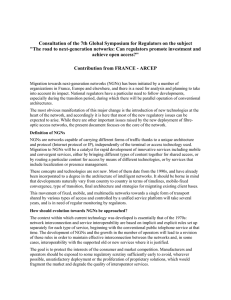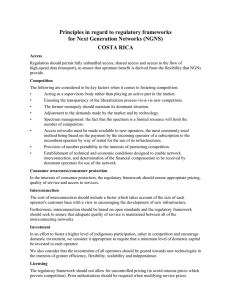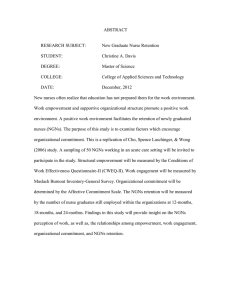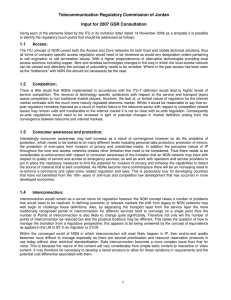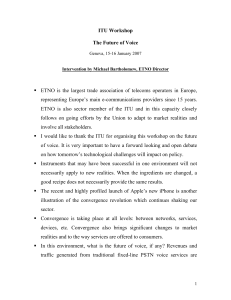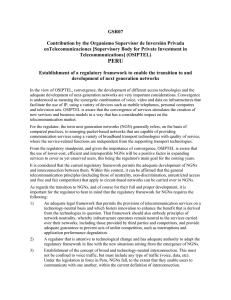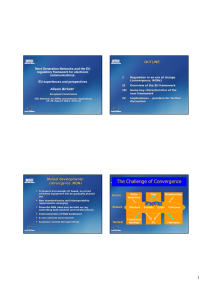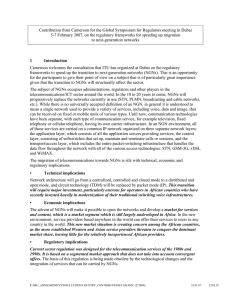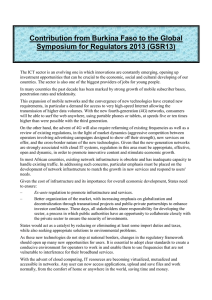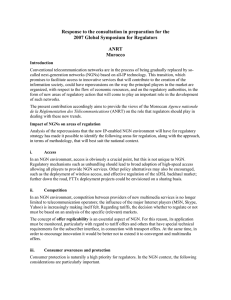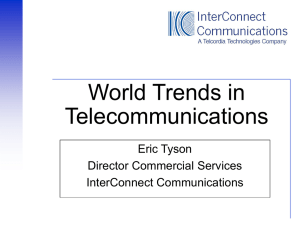OUTLINE
advertisement
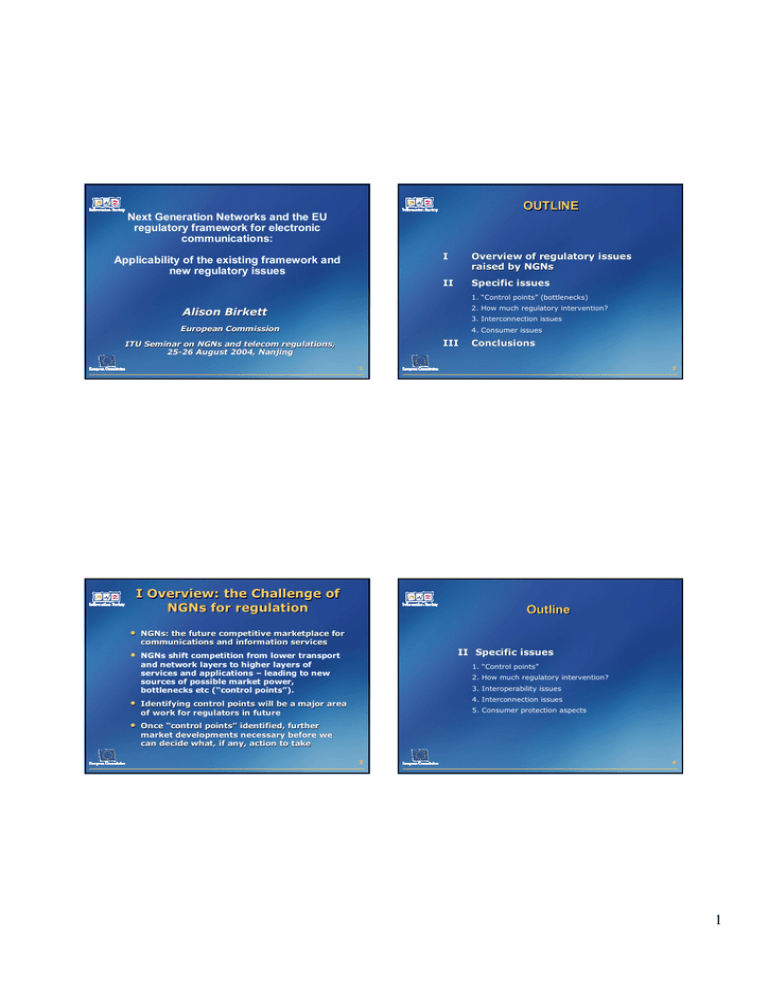
OUTLINE Next Generation Networks and the EU regulatory framework for electronic communications: Applicability of the existing framework and new regulatory issues I Overview of regulatory issues raised by NGNs II Specific issues 1. “Control points” (bottlenecks) 2. How much regulatory intervention? Alison Birkett 3. Interconnection issues European Commission 4. Consumer issues III ITU Seminar on NGNs and telecom regulations, 2525-26 August 2004, Nanjing Conclusions 1 I Overview: the Challenge of NGNs for regulation • NGNs: NGNs: the future competitive marketplace for communications and information services • NGNs shift competition from lower transport and network layers to higher layers of services and applications – leading to new sources of possible market power, bottlenecks etc (“control points”). • Identifying control points will be a major area of work for regulators in future • Once “control points” identified, further market developments necessary before we can decide what, if any, action to take 2 Outline II Specific issues 1. “Control points” 2. How much regulatory intervention? 3. Interoperability issues 4. Interconnection issues 5. Consumer protection aspects 3 4 1 List of relevant markets that may justify ex-ante regulation ex ex-ante 1. “Control points” • RETAIL (6 separate markets) To recall: the regulatory approach of EU framwork framwork:: • • 1. Identify markets • product markets (eg call termination): Commission has published a guide listing product/services markets which may be subject to ex-ante regulation • geographical markets (eg local, national, global) minimal and linked to degree of competition • flexible BUT harmonised at a European level • technologically neutral EU Minimum set of leased lines (up to 2 Mbit/s) Mbit/s) WHOLESALE (12 separate markets) 2. See whether there are dominant operators on those markets (Significant Market Power) • Access to PSTN (2 markets), telephone services (4 mkts) mkts) 3. Regulate only where an operator has a dominant position in an identified market where competition is not effective 4. Rely increasingly on competition law 5 • • • • • • • fixed: call origination, call termination, transit fixed: carrier selection and prepre-selection mobile: access & call origination, voice call termination mobile: international roaming leased line terminating segments, trunk segments unbundled (metallic) local loops, broadband access broadcast transmission services Potential control points (I) “Control points” (continued) • • Network Network Capabilities Capabilities • Control plane Study done for EU by Devoteam/Siticom 2003 identified list of potential “control points” in four different areas: • • • • 6 Transport plane Packet-Switched backb over optical fibre / • Network capabilities Circuit-Switched network (mobile operator) Elementary services PSTN Service access and content User information Access plane Study can be found at: http://europa.eu.int/information_society/to pics/ecomm/useful_information/library/stud ies_ext_consult/index_en.htm#2003 Wireless Circuit-Sw itched (e.g. GSM) • • • Termination capabilities • potential control point for the access operator Network address translators and firewalls • IPv4 to IPv6 translation between networks Routing tables • control over data flow and network usage Quality of service capabilities and interconnect • could become a control point for large operators Network coverage • could become a control point for large operators SOURCE: Devoteam Siticom & Cullen International 7 8 2 Potential control points(III) points(III) Potential control points (II) • Service Service access access and and content content Elementary Elementary Services Services Call setup capabilities • Unnecessary software and service • control over whether a service is performed over closed bundles Content Provider resources or open (shared) networks • security and/or quality may be a pretext for requiring service bundles • Proprietary standards Distribution Channel • may dictate what functions and services can be supported • NonNon-proprietary standards r no s io s h ip s r • may also affect balance of power between network operators • Walled gardens Access to Content • content restrictions imposed by access providers, differentiating availability of information and services Service Provider Ex pa and service providers • Interoperability trib • degree of interoperability between transport layer and service • Application programming interfaces (APIs) APIs) Subscriber record ork Intelligent network • Customer billing information • access is important for roaming and 3rd party service and d twork • Access to customer information systems • control of access by content providers to the customer External IP networks UMTS gateway • Name and number resolution (PSTN – IP conversion) conversion ) • could include ability to control routing (and therefore • Functions for determining location • potential control point for operators that collect location • establishing access rights that depend on legal (and ve financial) status SOURCE: Devoteam Siticom & Cullen International 10 Implications of these “control points”? User User Information Information Authentication, single log Authentication, log--on on,, user profile management • proprietary solutions can provide owners with significant De • certain types of content could become control points 9 Potential control points (IV) • • maintaining control over roaming users • Filter mechanisms and Digital Rights • specific services linked to hand-set capabilities IPR’s may make modifications illegal PSTN rvic e • Content • proprietary APIs may define what functions can be supported. Gateway Se • EndEnd-user devices layer will define the role of service providers SOURCE: Devoteam Siticom & Cullen International nel h an nC utio • Tunnelling • Not certain if they will emerge • Technological potential exists, but no consensus control over how and what user data can be shared about what will emerge in the real world • Could emerge on all levels, including important software content providers • They are not necessarily “bad” • It is legitimate to strive for competitive advantage • Driver for investments and innovation • Competitive barriers are often temporary base of an access provider • Questions to be answered: network usage) • Could a “control point” become an irreversible source of dominance? information (mobile operators) SOURCE: Devoteam Siticom & Cullen International • Could it lead to market failure unless regulated? 11 12 3 • 2. How much regulatory intervention? 3. Interoperability issues Some good reasons for not regulating: • Inappropriate actions would alter risk and reward calculations that drive investment • Interoperability functions? functions? • The “control point” could be a part of a new service- presumed not to be regulated between which • Unstable business model and service environment may be prematurely frozen • Factors to consider: consider: • Regulators rather than markets will pick winners and losers • The control point could fade away with new technology or other • service alternatives Two good reasons for regulatory concern: • If control by a single entity would lead to an irreversible source of dominance • • proprietary solutions with limited interoperability • standards, which define interoperability scenarios • IPRs and closed coding may prevent development of gateways • Or would lead to market failure unless regulated These are difficult judgements which require many types of skills 13 4. Interconnection issues 14 5. Consumer issues • Interconnection of networks • Using VoIP as an example: • Same regime for all types of traffic? • Or different regime for different types of traffic? • How to deal with consumers’ expectations about issues like access to emergency services and powered services? • Interconnection markets • Internet (peering, transit) • What happens to end-to-end service quality? • Who is reponsible for dealing with customer complaints about the service? • What happens to directory services? • What are the privacy and law enforcement implications of services provided across several jurisdictions? 15 16 4 Conclusions Outline III • An NGN environment will offer greater opportunities for third party service providers, but it may create more bottlenecks (“control points”). • Important to develop an understanding of sources of market power in an NGN world • Really important for regulators to develop crosscrossdisciplinary expertise needed to assess impact of NGNs (eg “control points”: Conclusions • 17 • Technology aspects • Legal aspects (eg Competition law) • Economic aspects Appropriate regulatory approach in NGN world is service rather than networknetwork- or technologytechnology-based • Transparency, fairness and proportionality in rules and rule--making are essential rule • Regulators around the world face similar problems: experience--sharing can be useful, and public experience consultations can bring invaluable input. 18 For more information ... EU regulatory framework http://europa.eu.int/information_society/topic s/ecomm/index_en.htm See also European Regulators Group (ERG) http://erg.eu.int http://erg.eu.int 19 5
